JAMBIANI, Zanzibar — As the tide recedes, sand flats emerge from the azure sea and the once-deserted beach buzzes with activity. There is a new moon — it’s bamvoua, “the time with the low tides” in the local dialect of Kiswahili.
Women wearing colorful fabrics called kanga hold baskets as they forage in sandy tide pools and children fish in the shallows with nets and lines. But further out, far beyond the rest, a group of women walk holding snorkels, masks, mesh bags and knives. They smile and chat as they dodge spiny sea urchins on their 20-minute trek through fine, sticky sand to tend to their submerged farms.
Historically, this area was dominated by seaweed farms — there are thousands of seaweed farmers between Jambiani and Kenya to the north, many of them providing rare jobs for women — but climate change has made growing seaweed increasingly difficult as water temperatures in shallow lagoons become too hot for seaweed to survive.
For these women wading out to sea, a novel, more profitable and resilient crop has emerged: sponges. There are only a handful of sponge farms in the world, mostly in the Federated States of Micronesia and other Pacific countries. These sponge farms on the southeast coast of Zanzibar’s Unguja Island are the first in the West Indian Ocean.
All 11 sponge farmers in the coastal town of Jambiani are women, most of them single mothers. The women own and run their own farms following a yearlong training set up by local conservation nonprofit Marinecultures, and they earn up to five times more than seaweed farmers. The work not only empowers them as they contribute to the local economy but it also gives them the independence to live in an increasingly expensive region and step out of women’s traditional roles on the Muslim island.
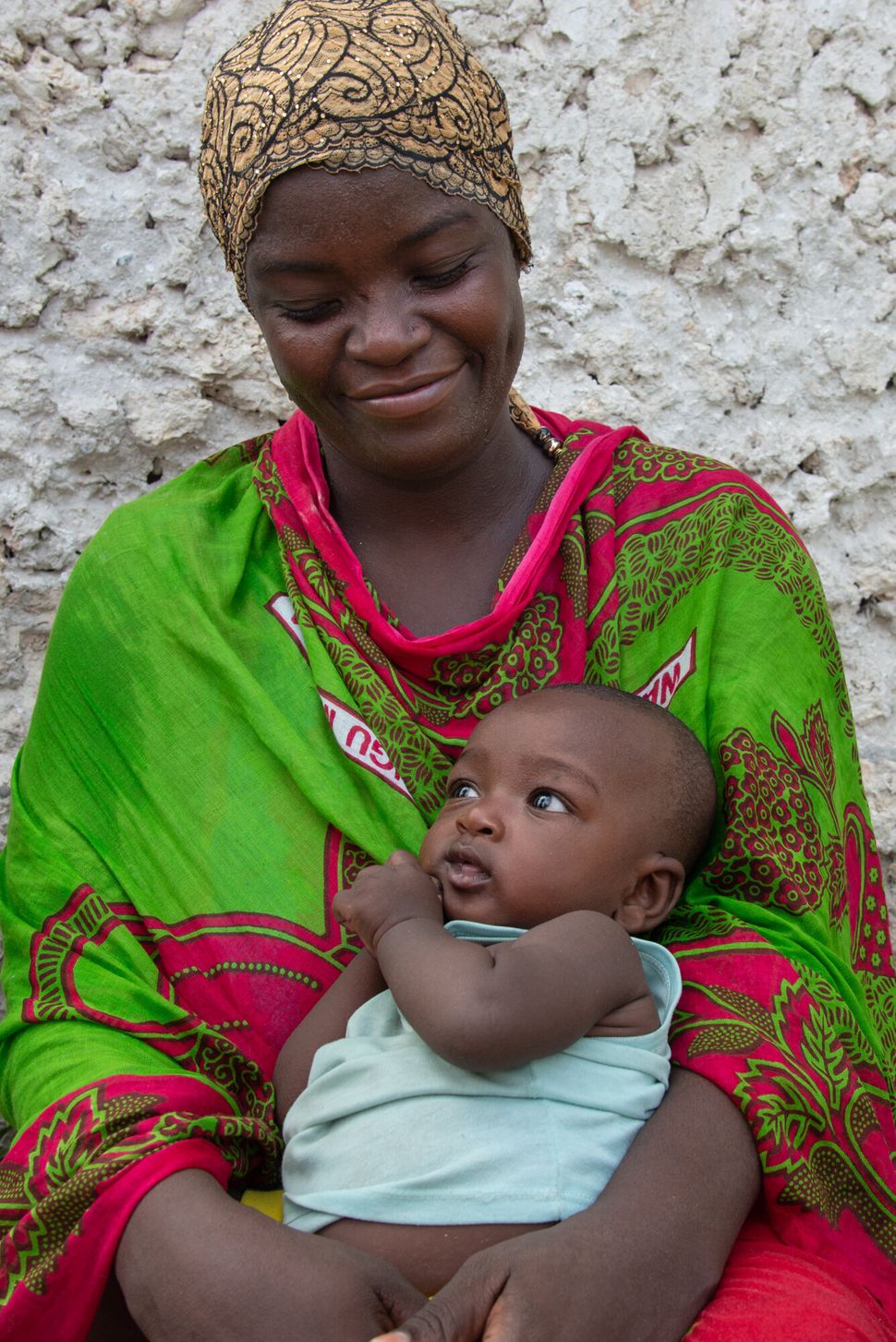
Jennifer Adler
“There is no work for most women,” said Zedi Abdallah Abdallah, as she holds a patient infant in her lap. She has farmed sponges for two years. “It has helped me a lot by allowing me to buy clothes for my children, buy furniture, etc. I would like more women to be engaged in sponge farming so that we may benefit together.”
Marinecultures was set up in 2008 with the goal of establishing sponge farming in the region. The NGO is led by managing director Christian Vaterlaus and his wife, Connie, who are both from Switzerland but have called Jambiani home for the past 15 years. Vaterlaus is tall with a kind smile and is generous with his knowledge. Out on the sponge farms, he seamlessly switches between Kiswahili and English.
When they started Marinecultures in Jambiani, “the main goal was to create jobs where the people can be independent,” said Vaterlaus. He did not want the jobs to be related to tourism because it can be unreliable with politics or terrorism (and now pandemics), plus, people who work in the sector usually speak English and are hired from mainland Tanzania.
The aim, said Vaterlaus, is to eventually no longer be involved at all, with locals entirely managing the business.
The sponge farms were first set up between 2010 and 2011 when Vaterlaus and local collaborators collected 600-800 sponge fragments from around Zanzibar to create a nursery in deeper waters. The fragments grew on ropes there until they were ready to plant on the new farms that still exist today.
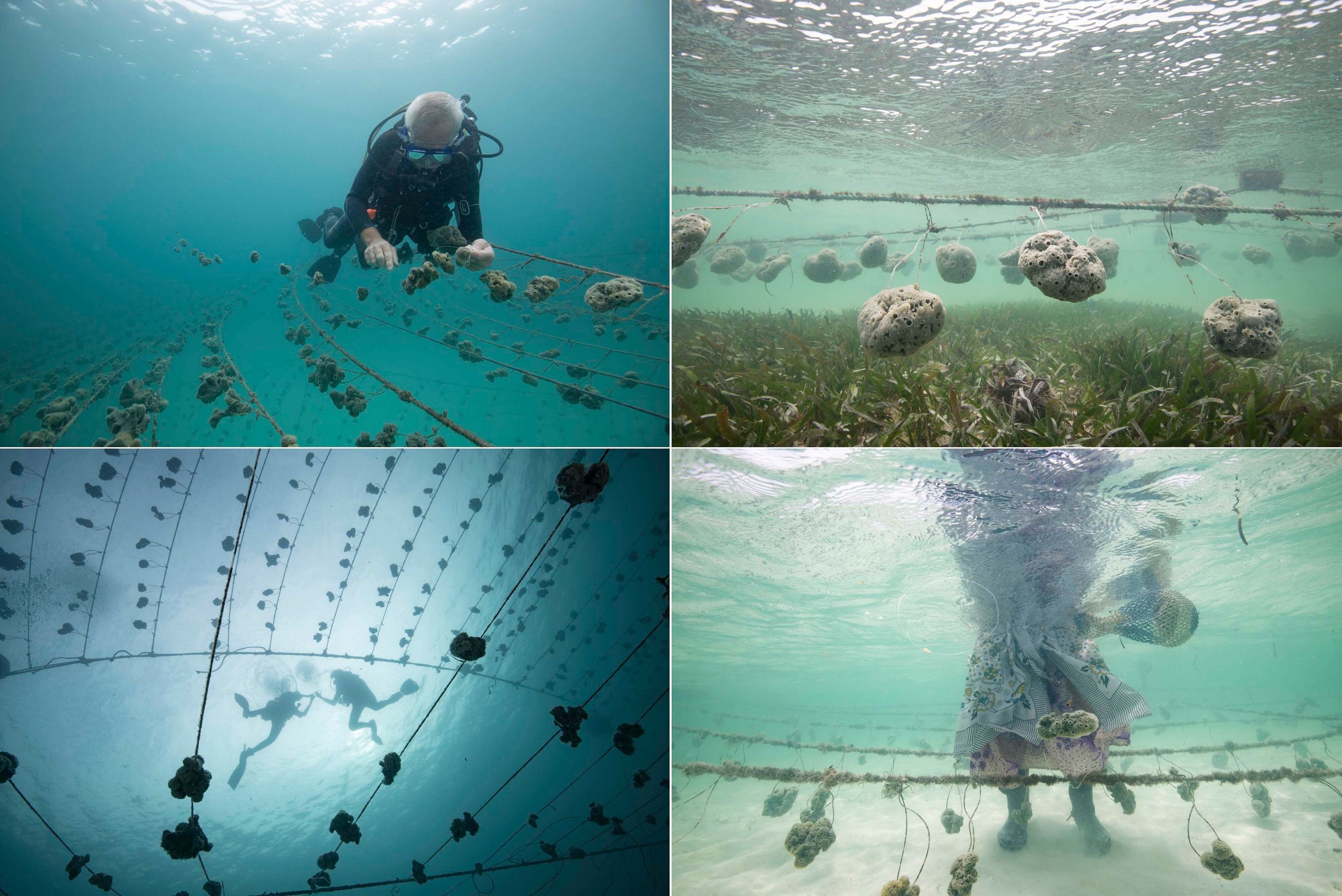
Jennifer Adler
The nursery is now home to more than 10,000 of the aquatic invertebrates (like coral, they appear plantlike but are actually very simple animals). Some sponges have been there for more than seven years, providing a long-term source for cuttings, called “seed” ― the farmers harvest 800 of these fragments per month from the nursery and use them to grow new sponges in the nearby, shallow-water farms.
Last year, they grew and sold about 500 sponges, which people use globally for bathing, cosmetics, and baby care.
The commercial sponge harvesting industry does not have great environmental credentials. About 99% of the sponges sold around the world are wild harvested, rather than farmed, according to Vaterlaus. Harvesting from the wild has largely wiped out sponge populations in other parts of the world ― a problem many countries in the Mediterranean have long struggled with.
Greece was once the center of the sponge trade. By the early 1900s, however, the country had exploited its natural sponge populations and moved to waters surrounding Egypt, Libya and Tunisia. In the 1930s, sponge divers in the Mediterranean harvested nearly 350 tons of sponges each year. After overharvesting in surrounding waters and being barred from harvesting in nearby countries in the 1980s, Greece resorted to harvesting sponges in Cuba and the Caribbean and importing them back home to sell as Greek sponges. Many Greek sponge divers also moved to Tarpon Springs, Florida, where a commercial sponge harvest continues today.
Small-scale sponge farming in the clear water of tropical lagoons, however, is a much more sustainable alternative with no negative impacts on the ocean. It doesn’t deplete wild populations or harm the seabed and it is a way for coastal communities to make a decent living, even in a changing climate.
“Sustainable, community-oriented aquaculture can be a powerful tool to generate income for coastal communities while enabling protection of the environment,” says Robert Jones, the global aquaculture lead at The Nature Conservancy. With low startup costs, these farms can provide “practical, alternative income streams for coastal communities.”
The sustainable aquaculture method was pioneered by researchers Richard Croft and Simon Ellis in Micronesia 20 years ago. Today, Ellis is the executive director of the Micronesia-based conservation nonprofit Marine and Environmental Research Institute of Pohnpei (MERIP) and a faculty member at the University of Hawaii Hilo.
“What we’ve done is develop commodities that [coastal communities] can grow,” Ellis said ― this gives people an option other than traditional fishing and farming.
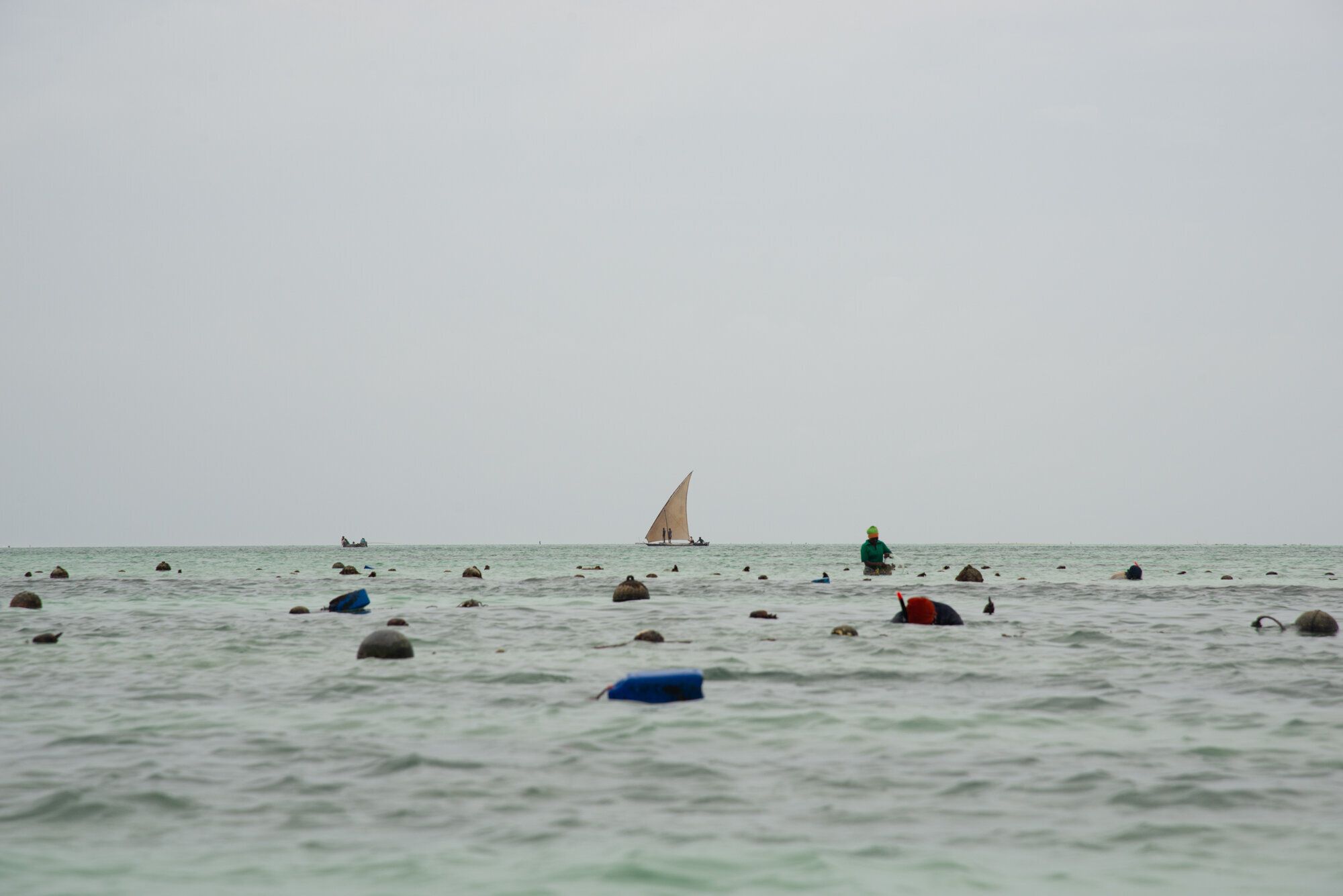
Jennifer Adler
Vaterlaus went to Micronesia to learn about sponge farming from Ellis in the early 2000s. “If you harvest one-third or so of the sponge, it will survive,” Vaterlaus said. “You have to leave enough for the sponge to regrow. It’s like a tree. If you really cut it down to the ground, it probably will not come again, but people usually take too much because they want the nice shape.” This is why harvesting generally decimates sponge populations.
Farming sponges is not only a more sustainable method for the industry, but it is also helping the local economy become more resilient in the face of climate change. Engaging rural fishers and farmers in alternative aquaculture activities “will reduce stress on over exploited inshore fisheries and upland forests and will also make communities less vulnerable to the effects of climate change in the long run,” wrote Ellis in a 2017 paper.
Many restorative benefits ― from water quality improvements to the provision of habitat for other organisms ― could come from farming species like sponges, says Jones.
Traditionally, Zanzibar has grown seaweed for export through international companies. The main product is carrageenan, a type of carbohydrate found in seaweed, which is used as a stabilizer and thickener in everything from ice cream to infant formula. But as the seas warm, the seaweed is suffering.
Unlike farmed seaweed, sponges fare well in warmer ocean temperatures. But they’re not without their own challenges. In 2018, the population of brittle sea stars (relatives of starfish) exploded. As they live in the sponges, it caused a great deal of damage. “It was a serious problem, like a fire in the farm,” Vaterlaus said. They lost about 40-45% of the sponges. This year, there was an especially large green algae bloom — Vaterlaus and his team were worried at first that it would slow the sponges’ growth, but with hard work, they were able to keep the sponges clean. Each season brings an unexpected event to keep the farmers learning and growing.
The farmers have persevered, even when it was difficult.
Vaterlaus said, while the community was welcoming from the start, it took time for people to come around to the benefits of sponge farming. “In the beginning, everyone was nice and smiling but there was not a lot of interest in [Marinecultures],” he said. But, as people watched them work hard over the years they began to be accepted, “and now [during COVID-19] there are nearly no expats, no people from the hotels, no tourists, and we are here — we continue our work. The continuity is what brings us the respect.”
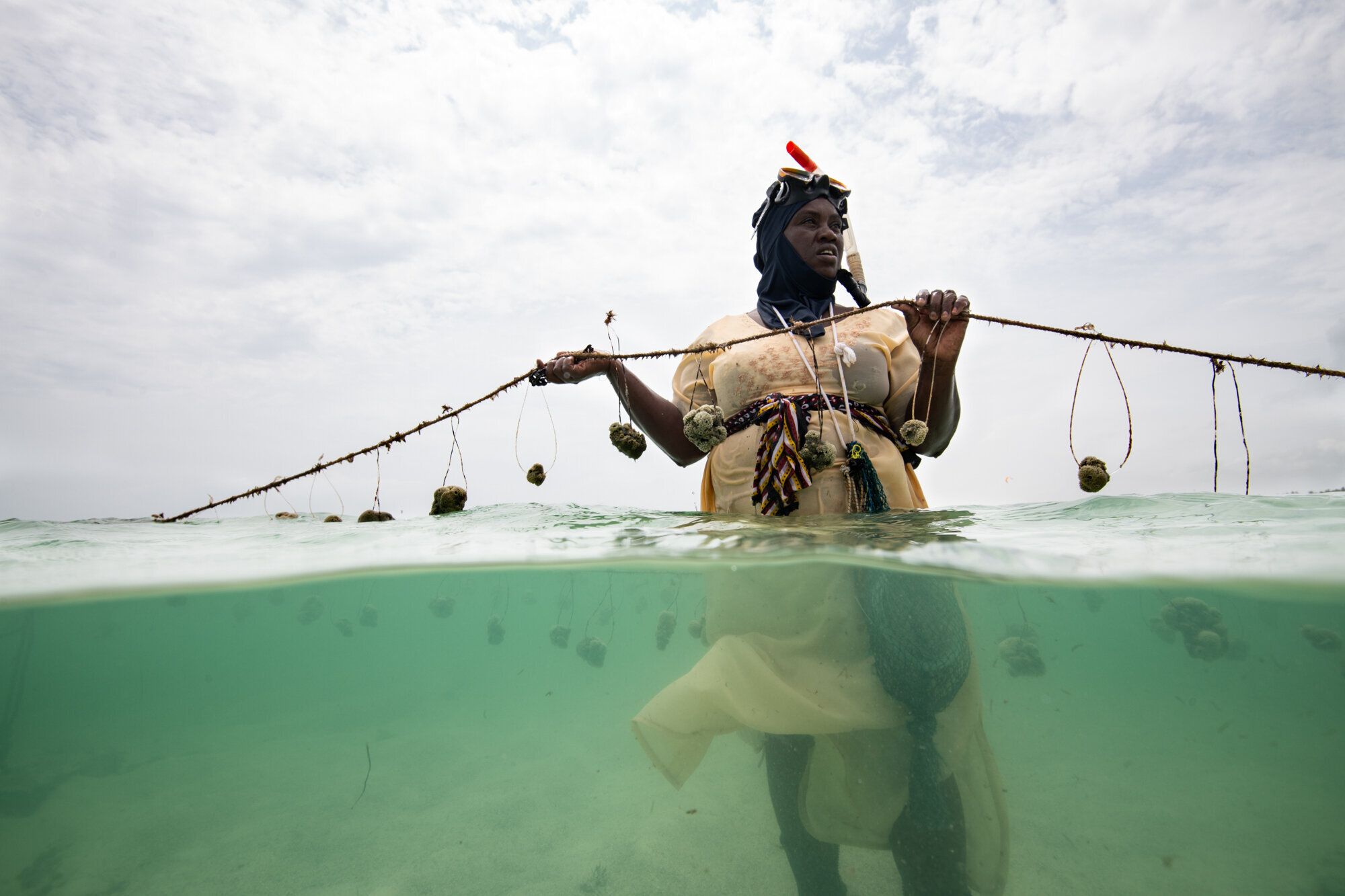
Jennifer Adler
Nasir Hassan Haji ― who farmed seaweed for a decade ― was the second person in Jambiani to join the yearlong sponge farming mentorship program offered by Marinecultures. Over the past five and a half years, she has helped train nine of the 11 women who farm sponges.
“I switched because seaweed farming does not have many benefits to us farmers,” Nasir said, referencing the low wages and control by huge corporations outside of Africa.
Being among Jambiani’s first female sponge farmers was challenging too, she said. “People were saying bad words to us like, ‘We are working freely by the white people,’ ‘Instead of farming seaweed they farm unknown things,’ ‘They never harvest,’ ‘They are always with nothing in their hands,’” said Nasir. “But when people started seeing what we earned, they stopped bullying us.”
The nursery and 11 farms combined are about half the size of a football field. From shore, they are barely visible as a few distant buoys floating at the surface obscured by the nearby neon kites of kiteboarding tourists which crisscross the sky.
Immersed in clear, chest-deep water with a strong ocean breeze, the farmers escape the heavy heat of the Zanzibari February summer. Just beneath the surface, rows of ropes hang horizontally, each holding 25-30 tan sponges. The women carefully secure individual sponges to the ropes with fishing line and tend to each one as tiny yellow fish take shelter in their kanga and wooden Zanzibari fishing boats head out to fish at the barrier reef.
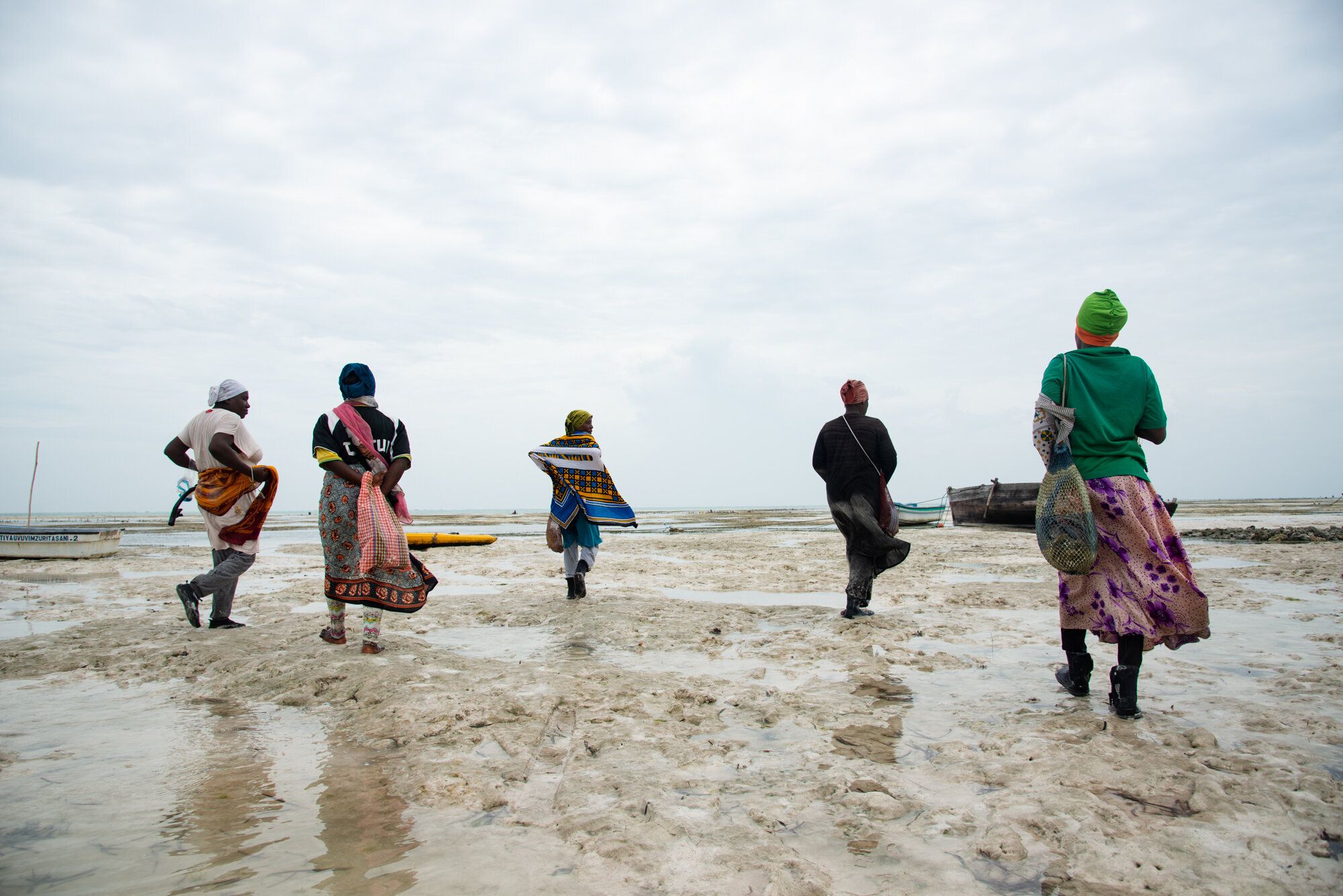
Jennifer Adler
These female sponge farmers are the first women in Jambiani to learn to swim, a skill they develop during their sponge farming mentorship with Marinecultures. Being comfortable swimming allows them to get out to their farms earlier and have the confidence to stay longer as the tide begins to rise.
“More people starting sponge farming is still slow because most are not aware of the meaning and benefits of sponge farming,” Nasir said. “When people find you have taken a mask and are heading to the sea, they think that you are going to swim in the deep water, so … they refuse. They are afraid of swimming in deep water.”
It takes about 12 to 15 months for the sponges to grow, suspended from ropes in the sea farms, before the women can harvest them ― but with sponges continually growing at different stages, they’re able to harvest year-round. After collecting sponges in the sea, the women meet at the Marinecultures center, a new white building with blue shutters on the sandy, winding streets of Jambiani, to process the sponges together.
First, they use a stick to pick out rocks and debris, followed by a rolling pin to push out any stubborn bits. Next, they wash the sponges in a series of freshwater baths in green buckets, kneading them in the water using soap made from local tree nuts called harita.
They pile the sponges on a kanga laid out on the floor. The women have spent so much time caring for their sponges that they can immediately tell which are theirs. They add blue tags with white lettering that says “Natural Sea Sponge Sustainably Farmed in Zanzibar” and sell them at about a dozen shops and hotels on the island. They now have requests from all over the world. Each sponge farmer gets 70% of the price her sponge sells for at the shop (usually priced at $20-25), and stores have to agree to this up front in order to sell the sponges.
Tourists are the main purchasers of the sponges, and since COVID-19 hit Zanzibar in March, the shops have been closed and there are no tourists. To help alleviate the financial burden, Marinecultures has started buying the sponges from the women, which it will hold until tourists come back or sell to other international markets.

Jennifer Adler
Marinecultures is now implementing a three-year plan to pass the project entirely to the local community. They are establishing a cooperative, which will ensure all farmers have equal rights when selling their sponges and the farmers in the cooperative will also handle quality control and training people to run a financially independent sponge nursery.
Women from nearby Michamvi will soon come to learn the trade from the women in Jambiani and start their own farms in their village a few miles to the north. In Madagascar, an NGO set up a test farm with support from Marinecultures. And there is additional interest from the Seychelles, mainland Tanzania and Mozambique.
Besides having positive impacts in the seas surrounding Jambiani, sponge farming is benefiting the community on shore. The opportunity to work and provide for their families is not only a powerful lifeline for these women, but for their children too whose worldview is being shaped by these female role models.
For the past few days, Shemsa Abasi Suleiman, who has farmed sponges for three years, has been bringing her 8-year-old son Feisal to the farm with her. While the water may be a bit deeper for him than her, she says, “Feisal loves to be a sponge farmer.”
Slowly, with each sponge plucked from the line, Shemsa and her colleagues are showing Jambiani what is possible.
Travel support for this story was provided by the Resilience Journalism Fellowship program at the Craig Newmark Graduate School of Journalism at CUNY.
HuffPost’s “Work In Progress” series focuses on the impact of business on society and the environment and is funded by Porticus. It is part of the “This New World” series. All content is editorially independent, with no influence or input from Porticus. If you have an idea or tip for the editorial series, send an email to thisnewworld@huffpost.com.


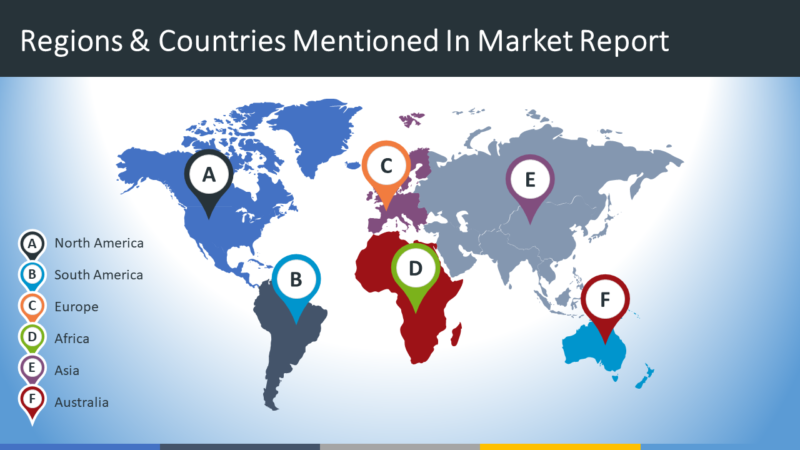


Recent Comments